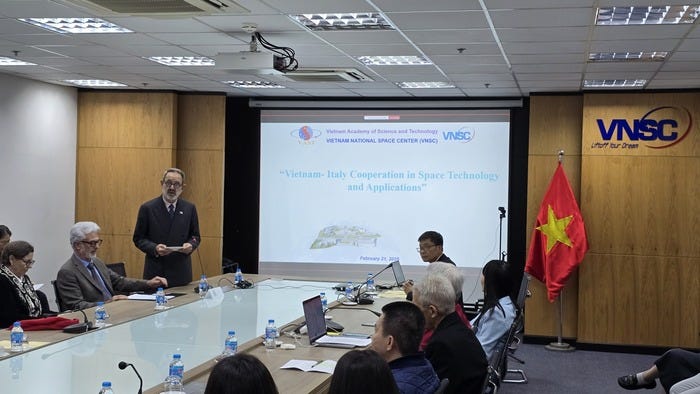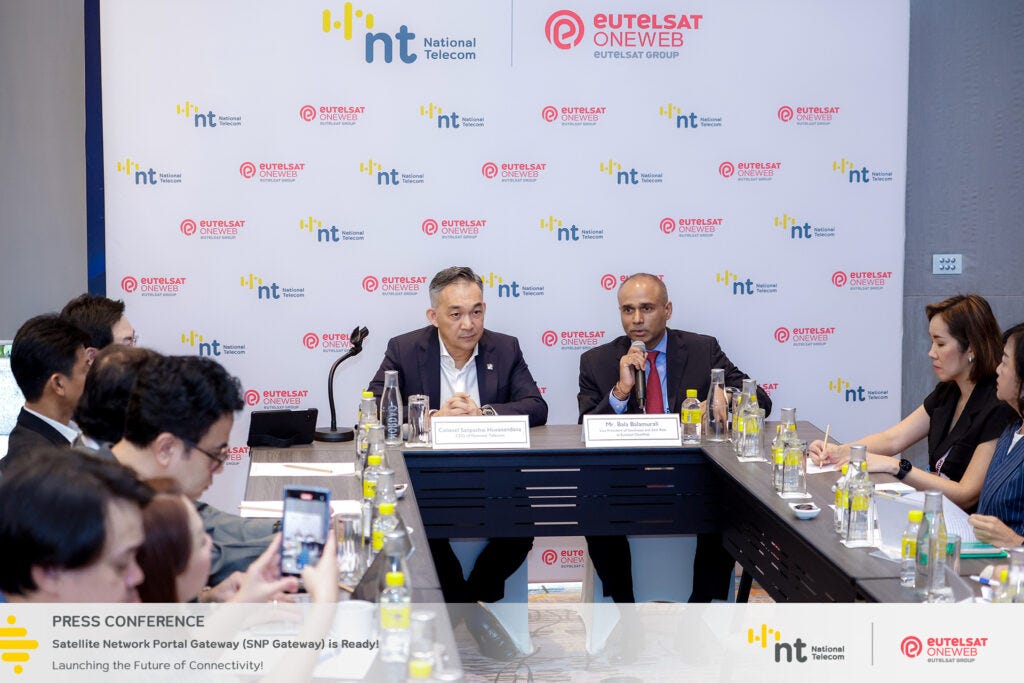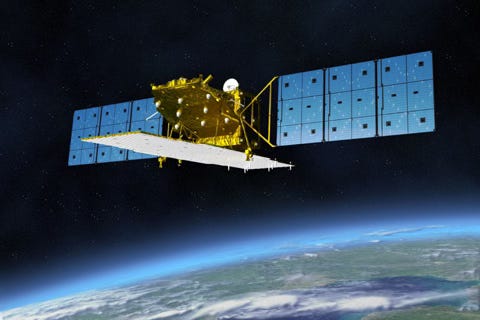Southeast Asia Space Roundup: 20 to 26 February 2025
A summary of all the space news in Southeast Asia over the past week, brought to you by AzurX
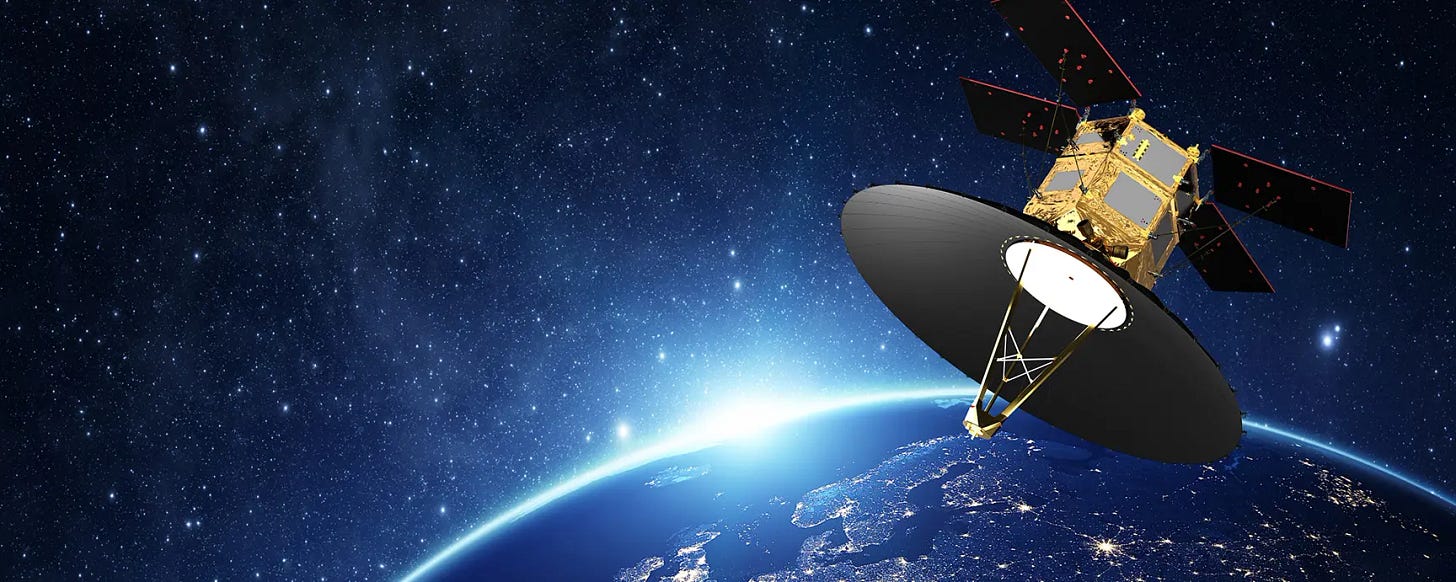
The following are the major space developments in the Southeast Asian region tracked by Southeast Asia Space Monitor over the past week:
Singapore Space Developments
Singapore’s ST Engineering Selected by UAE’s EDGE Group to Build Sirb SAR Satellite Constellation
The UAE’s EDGE Group, as the prime contractor for the UAE Space Agency’s Sirb Program, has partnered with Singapore’s ST Engineering to enhance the UAE’s synthetic aperture radar (SAR) satellite capabilities. The collaboration, formalized through a Letter of Intent (LoI), underscores the UAE's commitment to expanding its sovereign space sector and advancing high-resolution Earth observation. The Sirb Program, a national initiative, aims to bolster the UAE’s radar-based remote sensing capabilities, with ST Engineering providing expertise in SAR technology. This partnership aligns with the UAE’s National Space Strategy, fostering innovation, local industrial growth, and international cooperation. EDGE will oversee the development and deployment of a SAR satellite and ground segment, ensuring the UAE remains at the forefront of autonomous space systems. ST Engineering, known for its success with TeLEOS-1 and TeLEOS-2 satellites, will support the program by transferring key technical expertise. This collaboration strengthens the UAE’s position in satellite imaging, data analytics, and strategic space infrastructure, and bolsters Singapore’s ambition to be a global satellite manufacturing hub.

Singapore’s Global Space Technology Convention & Exhibition Held 26 to 27 February 2025
The Global Space Technology Convention & Exhibition (GSTCE) 2025, which begins on Wednesday, 26 February 2025, in Singapore, highlights the expanding role of space technologies in the global economy and cross-sector innovation. Organized by Singapore Space & Technology Ltd., this year’s event marks a milestone by integrating ten non-space industry sectors, reflecting space’s growing mainstream adoption. With 1,200 delegates from 45 countries, 60 exhibitors, and five national pavilions—including Japan, Singapore, Italy, India, and South Africa—the convention underscores how space is driving disruptive advancements in AI-powered geospatial intelligence, satellite-based connectivity, climate monitoring, and autonomous mobility. A key report released by Deloitte and Singapore Space & Technology projects that Earth observation data alone could add $100 billion to Southeast Asia’s GDP by 2030. Japan, the featured country at GSTCE 2025, showcases its JPY1 trillion ($6.693 billion) Space Strategy Fund and leading players such as JAXA, ispace, and Mitsubishi. With its expanded exhibition, industry-focused workshops, and a dedicated global B2B marketplace, GSTCE 2025 is positioned as a major platform for cross-sector collaboration, reinforcing the economic and technological impact of space beyond traditional aerospace industries.

Malaysia Space News
Minister: Malaysia Positioning Space Sector Within ASEAN; Mulling Artemis Accords
Malaysia is positioning its space sector as a collaborative rather than competitive effort within ASEAN, according to Deputy Science, Technology, and Innovation Minister Datuk Mohammad Yusof Apdal. While regional counterparts like Thailand and Singapore have signed the Artemis Accords, Malaysia is still evaluating its legal alignment with the agreement. The country is prioritizing the development of national space infrastructure, with the National Physical Planning Council mandating that space launch facilities align with urban planning regulations. A key initiative, the National Remote Sensing Satellite Development Programme (PSPJN), was approved in 2023 and is set to begin operations in 2028. This program aims to bolster Malaysia’s space technology capabilities by securing national ownership of critical satellite data, reducing reliance on foreign sources, and ensuring strategic autonomy in Earth observation. The government's commitment to developing indigenous satellite capabilities underscores Malaysia’s long-term space ambitions, aligning with its National Space Policy 2030 while maintaining a cooperative stance within the ASEAN space ecosystem.
Malaysia’s MOSTI & National Planetarium Promote Space Science and Astronomy With Malaysian Youth
Malaysia’s Ministry of Science, Technology, and Innovation (MOSTI), through the National Planetarium, continues to drive public engagement in space science and astronomy, aligning with the National Science, Technology, and Innovation Policy (NSTIP) 2021-2030. The latest initiative, the Astronomy Picnic, was hosted in collaboration with Putrajaya Corporation and GOLA Adventures Sdn Bhd to mark the rare planetary alignment occurring from January to March 2025. The event, which attracted over 1,500 visitors, featured astrophotography exhibitions, scientific workshops, and guided celestial observations. MOSTI Secretary-General Datuk Dr. Aminuddin Hassim underscored the initiative’s role in advancing Malaysia’s leadership in the ASEAN space economy while fostering interest in ‘Astro Tourism.’ By integrating government and private sector efforts, Malaysia aims to enhance public engagement in space science and nurture future talent in astronomy and related fields.
Malaysia’s SDEC to Use MEASAT Satellite Connectivity to Bridge Digital Divide
The Sarawak Digital Economy Corporation (SDEC) in Malaysia is accelerating efforts to enhance connectivity across Sarawak, particularly in underserved rural areas, through a combination of terrestrial and satellite solutions. As part of the Sarawak Multimedia Authority Rural Telecommunication (SMART) project, 600 telecommunication towers are being constructed, integrating Multi-Operator Core Network (MOCN) technology to enable multiple operators to share infrastructure, reducing deployment costs and improving service availability. While these towers are being built, SDEC is collaborating with MEASAT to deploy satellite broadband solutions as an interim measure, ensuring communities without network coverage gain internet access. Additionally, SDEC is working with infrastructure providers such as Sacofa, Borneo Restu, and Telekom Malaysia to strengthen Sarawak’s fibre network backbone. These efforts align with the Sarawak Linking Urban, Rural, and Nation (Saluran) initiative, a RM2.25 billion ($50 million) program aimed at improving internet accessibility through both temporary satellite-based services and long-term broadband infrastructure projects, including MySRBN and the Sebauh High-Speed Open Broadband Network. As of March 2024, 511 SMART towers have been equipped with telecommunication hardware, with 307 already operational, of which 251 provide 4G mobility services. The SMART project is slated for full completion by Q2 2025, positioning Sarawak as a leader in rural digital transformation.
Vietnam Space Developments
Vietnam’s National Assembly Approves Pilot Scheme for LEO SATCOM Services
Vietnam’s National Assembly has approved a pilot program to develop low-Earth orbit (LEO) satellite telecommunications, marking a significant step in the country’s digital transformation strategy. The initiative, set to run for up to five years and ending by 1 January 2031, aims to enhance national connectivity, particularly in remote areas, while ensuring compliance with defense and security requirements. The Ministry of Science and Technology will oversee licensing and regulation, while the Ministries of National Defense and Public Security will monitor implementation. Experts highlight LEO satellites’ potential to bridge the digital divide, improve disaster response, and enhance Vietnam’s surveillance and environmental monitoring capabilities. The move builds on Vietnam’s previous satellite ventures, including VNREDSat-1 and Microsat-1, launched with India’s support. While global players like SpaceX deploy thousands of LEO satellites, Vietnam is expected to adopt a phased approach due to high launch and operational costs. The program presents opportunities for domestic technology development and greater self-reliance but requires careful planning to manage space debris and long-term sustainability.
Vietnam Legislation Allows Autonomy and Funding Flexibility in Space and Satellite Programs
Vietnam's National Assembly has approved a groundbreaking resolution that embraces risk in scientific research, granting greater autonomy and funding flexibility to drive technological advancements, particularly in space and satellite development. The policy shift, rooted in Resolution 57-NQ/TW, aims to remove regulatory barriers, enabling research institutions to commercialize innovations, form strategic partnerships, and adopt business-oriented management models. This move is crucial for Vietnam’s ambitions in space technology, building on past satellite initiatives such as VNREDSat-1 and Microsat-1, which have supported environmental monitoring and disaster management. Industry leaders, including Viettel’s CEO Tao Duc Thang, have emphasized the need for flexible policies to attract global technology collaborations, a key factor in expanding Vietnam’s satellite capabilities. The resolution also ensures that state-funded research institutions are shielded from financial liability if projects fail, fostering a dynamic environment for innovation in satellite communications, remote sensing, and AI-driven space applications. Deputy Minister of Science and Technology Bui The Duy stressed that embracing calculated risks is essential for Vietnam to develop sovereign space capabilities and reduce reliance on foreign technologies. By aligning its policies with global best practices and leveraging expertise from space-faring countries like Japan, China, and South Korea, Vietnam aims to establish itself as a regional leader in space technology, advancing its role in Earth observation, climate resilience, and national security.
Vietnam and Italy Celebrate Italian Space Day 2025 at VNSC Headquarters
Italian Space Day 2025 was marked in Hanoi with a scientific workshop and an art exhibition at the Vietnam National Space Center (VNSC), underscoring growing collaboration between Italy and Vietnam in space technology and applications. Ambassador Marco della Seta and VNSC Deputy Director General Vu Anh Tuan introduced the workshop, which convened experts and institutional representatives from both countries to explore cooperative opportunities in satellite technology, Earth observation, and research. The event also featured the opening of The Italian Spaceway exhibition, showcasing Italy’s contributions to space innovation, with a dedicated section highlighting Vietnam’s space advancements. Established in 2021, Italy’s National Space Day serves as a platform to promote its expertise in the global space sector while fostering international partnerships. The initiative reflects the increasing role of bilateral cooperation in space science, particularly as Vietnam advances its National Space Strategy and seeks new international collaborations to enhance its capabilities.
Thailand Space News
Thailand’s NT Telecom Partnership With Eutelsat OneWeb Faces Regulatory Delays
Thailand’s partnership between state enterprise National Telecom (NT) and Eutelsat OneWeb to provide LEO satellite broadband services is facing regulatory delays as the National Broadcasting and Telecommunications Commission (NBTC) finalizes guidelines. NBTC acting secretary-general Trairat Viriyasirikul emphasized that LEO broadband services must align with Thailand’s Space Business Act and the national master plan for the space economy, which is currently under review. While NT and Eutelsat OneWeb have secured approval to operate internationally under NT’s landing rights, local market operations are still pending regulatory clearance. The partnership, which launched a satellite network portal gateway in January 2025, has already attracted over $25 million in investment for local infrastructure, with NT projecting annual revenue of 200 million baht ($5.937 million) from the gateway. The facility, located at NT’s Sirindhorn satellite earth station in Ubon Ratchathani, is expected to support over 50,000 users across Southeast Asia, excluding Thailand until domestic approval is granted. The initiative is part of Thailand’s broader strategy to develop its space economy, which is projected to reach a market value of 300 billion baht ($8.9 billion) by 2032, reinforcing the country's ambitions to become a regional player in satellite communications and space technology.
Thailand’s NBTC Seizes Illegal Satellite Dishes Near Border With Laos as Part of Crackdown on Scam Call Centers
Authorities in Thailand have uncovered illegal wireless Internet stations transmitting signals into Laos, raising serious security concerns about cross-border telecommunications activity. Led by the National Broadcasting and Telecommunications Commission (NBTC) and local police, the investigation identified three suspect stations near the Lao border, including one on a hotel rooftop just 1.24 kilometers from Laos. These stations, equipped with satellite dishes and broadband cables, are believed to have facilitated unauthorized cross-border Internet access. While ownership remains unclear, authorities are tracing broadband accounts to identify those responsible. Unauthorized telecommunication operations in Thailand carry severe legal penalties, and investigators suspect potential links to illicit business activities. In response, Thai authorities are tightening border security and enhancing surveillance to prevent future illegal broadcasts. The crackdown on unlicensed telecom networks continues, with officials urging public cooperation in reporting any suspicious activity.
Other Regional Space Developments
Philippine Space Agency and Japan’s JAXA Hold ALOS-2 Ideathon
The Philippine Space Agency (PhilSA), in collaboration with JAXA, RESTEC, Keio University, and the University of the Philippines, hosted the ALOS-2 Ideathon Workshop from 17 to 18 February 2025, in Quezon City. The workshop focused on leveraging data from JAXA’s Advanced Land Observing Satellite-2 (ALOS-2), equipped with the PALSAR-2 radar sensor, which enables all-weather, day-and-night Earth observation. Participants from government agencies, academia, and NGOs explored practical applications of satellite data for urban flooding mitigation, deforestation monitoring, and disaster response. Building on a previous 2023 training session, this initiative strengthens capacity-building efforts in the Philippines by enhancing technical proficiency in satellite-based environmental monitoring. Such collaborations highlight the growing role of Earth observation in addressing regional sustainability challenges.
Cambodia and SpaceX’s Starlink In Talks On Investment and LEO SATCOM Services
SpaceX’s Starlink has identified Cambodia as a priority investment target for 2025, with company representatives engaging with government officials to assess the country’s investment environment and technological modernization efforts. During a meeting with Deputy Prime Minister Sun Chanthol, Starlink’s Director of Market Access, Rebecca Hunter, outlined the company’s interest in strengthening ties with the Cambodian government and exploring opportunities for satellite connectivity expansion. Chanthol welcomed the initiative, emphasizing Cambodia’s focus on digital transformation as a key priority under the Pentagon Strategy-Phase 1. The discussions build on Cambodia’s growing engagement with SpaceX, following Chanthol’s visit to the company’s headquarters in California in September 2024, where he examined the latest satellite technologies and operational efficiencies enabled by Starlink’s global network. The meeting signals Cambodia’s ambition to leverage advanced space-based communication solutions to accelerate its digital economy and connectivity infrastructure.
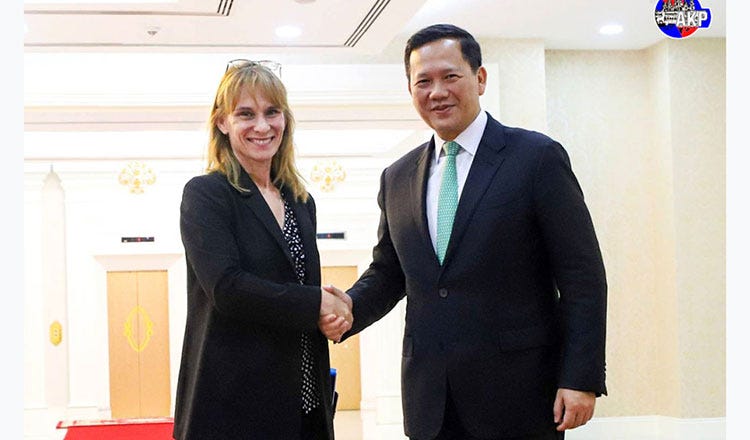
South Korea’s Dabeeo and Sooin Partner to Provide Satellite-Enabled AgriTech Solutions in Southeast Asia
South Korean geospatial AI firm Dabeeo has signed an MoU with controlled-release fertilizer specialist Sooin to expand AI-driven smart agriculture across Southeast Asia, particularly in palm plantation operations. Dabeeo’s solution utilizes ultra-high-resolution satellite imagery and AI analysis to monitor individual palm tree health, enabling early disease detection and precision intervention. Already deployed across plantations in Indonesia and Malaysia, Dabeeo plans to establish a regional subsidiary in Indonesia and launch a mobile app for real-time monitoring. Sooin, a key fertilizer distributor in Indonesia, Malaysia, and Thailand, will integrate Dabeeo’s technology to optimize fertilizer application through data-driven insights. The partnership aims to enhance farm productivity by combining AI-powered tree health assessments with customized nutrient solutions, supporting major plantation operators such as Sime Darby, Tabung Haji, and Felda. This collaboration is set to establish a new benchmark for AI-driven precision agriculture in Southeast Asia, improving sustainability and efficiency in the region’s vital palm oil industry.
Be sure to catch up with space activities in the region in the next edition of Southeast Asia Space Monitor’s space roundup!






